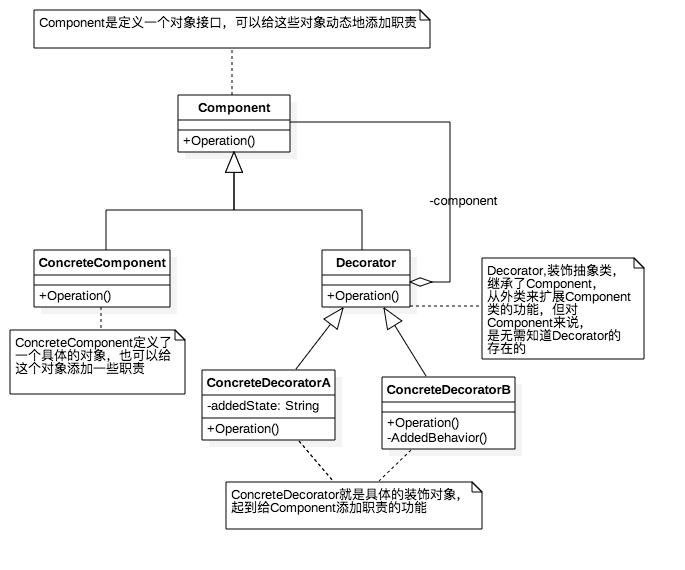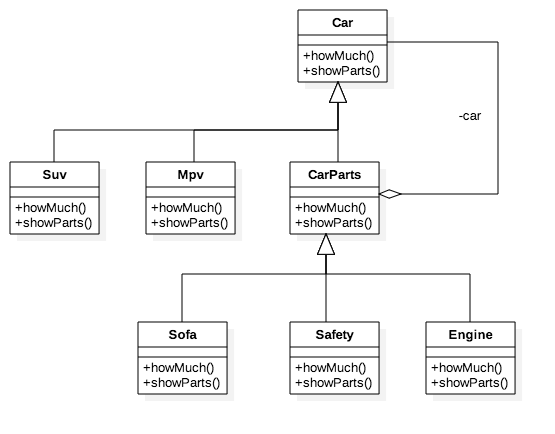标签:print class action shanghai .net ase cti alt 缺点
在不必改变原类文件和使用继承的情况下,动态地扩展一个对象的功能。它是通过创建一个包装对象,也就是装饰来包裹真实的对象。

上图是最基本的装饰模式的结构图,下面将用Swift代码来实现一个基本装饰模式:
1).先写一个Component接口
protocol Component {
func operation()
}2).写一个具体的Component对象
class ConcreteComponent: Component {
func operation() {
// 具体操作的实现
}
}3).写一个装饰抽象类
class Decorator: Component {
var component: Component?
func operation() {
component?.operation()
}
}4).写具体的装饰对象
// 装饰对象A
class ConcreteDecoratorA: Decorator {
private var addedState: String?
override func operation() {
super.operation()
addedState = "ConcreteDecoratorA独有的功能,用来区分ConcreteDecoratorB"
// 具体装饰对象A的操作
}
}
// 装饰对象B
class ConcreteDecoratorB: Decorator {
override func operation() {
super.operation()
addedBehavior()
// 具体装饰对象B的操作
}
// ConcreteDecoratorB独有的方法,用来区分ConcreteDecoratorA
private func addedBehavior() {
}
}通过以上代码我们就能简单了解装饰模式的基本实现于过程,它的主要的目的就是:在不必改变原类文件和使用继承的情况下,动态地扩展一个对象的功能,就像以上示例代码一样,通过ConcreteDecoratorA与ConcreteDecoratorB去扩展ConcreteComponent这个对象的功能,这样不用去改变ConcreteComponent这个类的源文件,也可以达到扩展的效果。
下面通过一个实际的例子来看看,比如我们在买车的时候一般会选配很多配件,下面我们通过策略模式来实现这一过程,下上个结构图:

下面贴上代码:
// Component
protocol Car {
// 多少钱
func howMuch()-> Int
// 展示装配的配件
func showParts()
}
// ConcreteComponents
class Suv: Car {
init(owner: String) {
print("\(owner)买了一辆Suv,10W")
}
func howMuch() -> Int {
return 10
}
func showParts() {}
}
class Mpv: Car {
init(owner: String) {
print("\(owner)买了一辆Mpv,15W")
}
func howMuch() -> Int {
return 15
}
func showParts() {}
}
// Decorator
class CarParts: Car {
var car: Car?
func howMuch() -> Int {
return car?.howMuch() ?? 0
}
func showParts() {
car?.showParts()
}
func decorator(_ car: Car) -> Car {
self.car = car
return self
}
}
// ConcreteDecorators
class Sofa: CarParts {
override func howMuch() -> Int {
return super.howMuch() + 1
}
override func showParts() {
super.showParts()
print("选配了真皮沙发,1W")
}
}
class Safety: CarParts {
override func howMuch() -> Int {
return super.howMuch() + 3
}
override func showParts() {
super.showParts()
print("选配了全套安全系统,3W")
}
}
class Engine: CarParts {
override func howMuch() -> Int {
return super.howMuch() + 5
}
override func showParts() {
super.showParts()
print("选配了V8发动机,5W")
}
}下面我们使用一下以上代码看看:
//wcl买一辆suv
var suv: Car = Suv(owner: "wcl")
//装配沙发
suv = Sofa().decorator(suv)
//装配发动机
suv = Engine().decorator(suv)
//装配安全系统
suv = Safety().decorator(suv)
suv.showParts()
print("一共花了\(suv.howMuch())W")
print("\n")
//wcl买一辆mpv
var mpv: Car = Mpv(owner: "wcl")
//装配发动机
mpv = Engine().decorator(mpv)
//装配安全系统
mpv = Safety().decorator(mpv)
mpv.showParts()
print("一共花了\(mpv.howMuch())W")以下是代码打印的结果:
wcl买了一辆Suv,10W
选配了真皮沙发,1W
选配了V8发动机,5W
选配了全套安全系统,3W
一共花了19W
wcl买了一辆Mpv,15W
选配了V8发动机,5W
选配了全套安全系统,3W
一共花了23W这样就用装饰模式简单了实现了一下这个过程,在不改变Suv于Mpv这两个类的源文件的情况下对它进行操作。
我们先看看装饰模式的优点:
装饰模式的缺点:
标签:print class action shanghai .net ase cti alt 缺点
原文地址:http://www.cnblogs.com/chengyu891/p/6383809.html